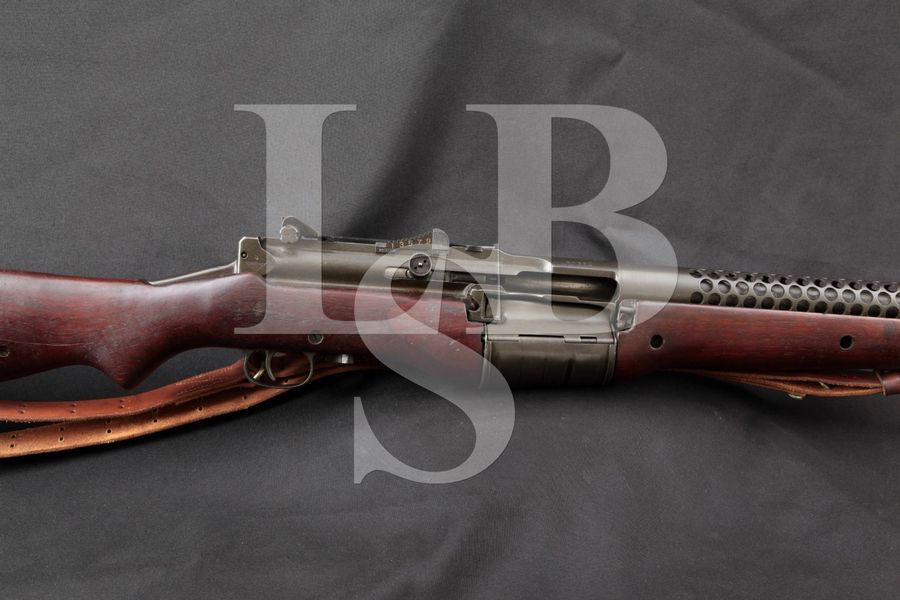
Johnson Automatics Model 1941, Parkerized 22 1/2” RARE WWII Semi-Automatic Rifle, MFD 1941-1945 C&R
LSB#: 160132WM34
Make: Johnson Automatics
Model: 1941
Serial Number: B0320
Year of Manufacture: 1941-1945
Caliber: .30-06 Springfield
Action Type: Semi Auto, 10 Round Internal Rotary Magazine
Markings: The top of the receiver is marked with patent information, the serial number, “CAL. 30-’06 SEMI AUTO.” and “’JOHNSON AUTOMATICS’ / MODEL OF 1941 / MADE IN PROVIDENCE, R.I., U.S.A.”. The right rear of the receiver is marked “CRANSTON / ARMS / CO” in an inverted “triangle”. The face of the metal barrel shroud is marked “.30-06” on top and “41” on the bottom; this piece of circular metal is actually attached to the barrel. The top of the barrel, under the shroud, is marked “J.A. / .30-‘06”. The right side of the bolt is marked “C0216”. The left front of the rear sight elevator is marked “M2”. The bottom of the stock to the rear of the magazine is marked “0”.
Barrel Length: Approximately 22 1/2 Inches
Sights / Optics: The front sight is a post set between two protective ears atop a raised base. The rear sight is a windage adjustable aperture. The adjustment knob functions. The aperture is set on a sliding elevator. It is marked “METERS 0-1000” and “1 3 5 7 9” on the right. The top is marked “0” and with hash marks.
Stock Configuration & Condition: The two piece hardwood stock has a pistol grip, several holes for mounting screws, a metal barrel shroud, two sling swivels and a metal buttplate. The bottom right of the forearm and the left side of the grip each show a small area of vertical scratches. The left rear of the forearm is missing small edge chips; this area has been finished over. There are various other scrapes and compression marks. The LOP measures 13 1/4 inches from the front of the trigger to the back of the buttplate. The stock rates in about Very Good to Fine overall condition.
Type of Finish: Parkerized
Finish Originality: Original
Bore Condition: The bore is semi bright and the rifling is crisp. There is light erosion in the grooves and at the muzzle. The bore shows an M.E. of 1.
Overall Condition: This rifle retains about 96% of its metal finish. The magazine shows a freckling of frosting and some scratches. The buttplate edges show thinning. The metal shows some light scrapes, discoloration from oxidation and a few small patches of light frosting. The screw heads need to be cleaned; some of them show use. The markings are deep. Overall, this rifle rates in about Very Good to Fine condition.
Mechanics: The action functions correctly. We have not fired this rifle. As with all previously owned firearms, a thorough cleaning may be necessary to meet your maintenance standards.
Box, Paperwork& Accessories: The rifle comes with a leather sling that shows scrapes, compression marks and oxidation on the metal tabs. It is in about Very Good to Fine condition.
Our Assessment: This Johnson Automatics Model 1941 is in great shape for a rifle that is in its 70’s. We don’t see these rifles much as not many were made and those that are still around live in very nice safes with other very collectible rifles. Now you have the chance to own one. Some basics from Wikipedia: “The M1941 Johnson Rifle was an American short-recoil operated semi-automatic rifle designed by Melvin Johnson prior to World War II. The M1941 competed unsuccessfully with the U.S. M1 Rifle…The M1941 rifle used the energy from recoil to operate the rifle. As the bullet and propellant gases moved down the barrel, they imparted a force on the bolt head that was locked to the barrel. The barrel, together with the bolt, moved a short distance rearward until the bullet left the barrel and pressure in the bore had dropped to safe levels. The barrel then stopped against a shoulder allowing the bolt carrier to continue rearward under the momentum imparted by the initial recoil stage. The rotating bolt, which had eight locking lugs, would then lock the bolt. Following, a cam arrangement then rotated and unlocked the bolt to continue the operating cycle. One disadvantage of this design was its impact on the use of a bayonet, as the complex movements of the barrel would be subject to unacceptable stress when a bayonet thrust was used. The Johnson rifle utilized a unique 10-round rotary magazine and a two-piece stock, the weapon using the same 5 round stripper clips used by the M1903 Rifle. This system had some advantages over the M1 Rifle, including less perceived recoil and greater magazine capacity. Unfortunately, the Johnson’s recoiling barrel mechanism resulted in excessive vertical shot dispersion that was never fully cured during its production life, and was prone to malfunction when a bayonet was attached to the reciprocating barrel. The Johnson also employed a number of small parts that were easily lost during field stripping.”

